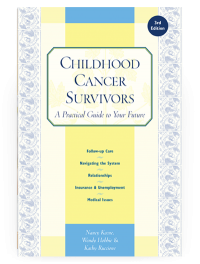Childhood Cancer Survivors
Chapter 1. Survivorship
From the time of discovery and for the balance of life, an individual diagnosed with cancer is a survivor.
— National Coalition for Cancer Survivorship
MANY OF the 12,400 children and adolescents (under age 20) diagnosed each year with childhood cancer can now be cured. Survivors of childhood cancer often find that the illness and its treatment changed their lives in many powerful, and often positive, ways. There is much to celebrate.
However, long-term survivors of childhood cancer face an uncertain future. The surgery, radiation, chemotherapy, and stem cell transplants used to cure children sometimes affect growing bodies and developing minds. Complications from these treatments may occur later in life and are known as late effects. In addition, some survivors encounter job discrimination, difficulties obtaining insurance, and emotional or social difficulties.
During your (or your child’s) journey through the many phases of survivorship, you may find yourself educating your family, friends, and healthcare providers about your physical and psychological responses to treatment and its aftereffects. Knowing about your disease, its treatment, and potential late effects will help you advocate for the care you need to maximize your health and well-being.
This chapter discusses some of the many facets of survivorship. It covers the transition from active treatment to going off treatment. It also discusses the shift from childhood to the independence of adulthood. To take charge of your health, you need to collect information about your treatment and then assemble a team to help chart your medical course. This chapter discusses ways to find the best healthcare providers for your unique needs.
Table of Contents
All Guides- 1. Survivorship
- 2. Emotions
- 3. Relationships
- 4. Navigating the System
- 5. Staying Healthy
- 6. Diseases
- 7. Fatigue
- 8. Brain and Nerves
- 9. Hormone-Producing Glands
- 10. Eyes and Ears
- 11. Head and Neck
- 12. Heart and Blood Vessels
- 13. Lungs
- 14. Kidneys, Bladder, and Genitals
- 15. Liver, Stomach, and Intestines
- 16. Immune System
- 17. Muscles and Bones
- 18. Skin, Breasts, and Hair
- 19. Second Cancers
- 20. Homage
- Appendix A. Survivor Sketches
- Appendix B. Resources
- Appendix C. References
- Appendix D. About the Authors
- Appendix E. Childhood Cancer Guides (TM)

